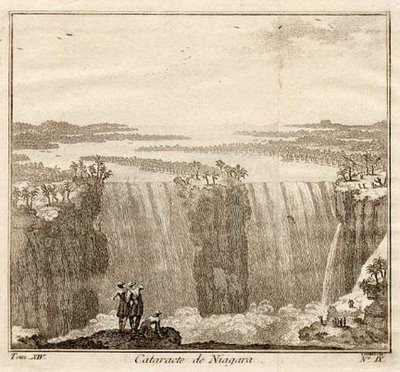
[Image: Julius Popp's Bitfall].
Bitfall, pictured above, is a kind of liquid computer monitor. As Ruairi Glynn, of Interactive Architecture dot Org, describes it, Bitfall uses carefully-timed drops of falling water "to project images taken from the internet. A computer observes various news websites and chooses thereafter the images to be displayed. 128 nozzles are controlled by synchronised magnetic valves, and the water drops falling to the ground shape the images. The visual information is only tangible for a second before the drops merge to become water again."
The sheet of falling water, then, becomes a screen – a liquid cinema – a monitor on which to surf the web.

All of which would be amazing enough were it not for some unbelievable landscape design possibilities.
You're in Rome, and you decide to visit the Trevi Fountain – but you're confused. Is that an image you see in the cascading water...? You look closer and realize a television show is being played using the water itself. The whole city, in fact, is full of fountains, and they're all playing films, news shows, stationary images of art. It begins raining later that evening, and you swear you see films in the falling water...
Then fountains are installed in red light districts around the world, showing porn...
The next summer huge gates are attached to the top of Niagara Falls, and every August a film fest begins: you sit down on the Canadian side of the border and watch Hitchcock, Truffaut, Roberto Succo, an almost-subliminal cinema roaring downward into mist with the water.

A computer-controlled showerhead is installed in your home bathroom, and you watch the news, or put on a film and... do whatever while you watch it. Headlines falling on your shoulders from above.
Hotel lobbies with fake waterfalls are transformed into newsrooms, with financial information trickling down the corporate surface of the falls. From different angles you receive different information; from further away you see different films.
The New York Stock Exchange replaces its news tickers with fountains: the Dow, the FTSE, the price of mined tungsten. Mineral futures. All cascading inside smooth surfaces of water.

[Image: Asymptote's re-design of the NYSE].
Soon trees can be genetically altered to form images in their bark: tree-screens. You accidentally stumble into a test-forest, after a car accident in rural Bavaria, and all the trees around you seem covered in pictures, and certain angles make them all add up into a 3D film...
Filmstills from award-winning directors of the past are put into genetically modified flowers; you look closely and it's Hollywood Ninja, frame by frame, growing in your bestfriend's garden. When breezes come, short scenes go animated, looped. Hypnotic. The film garden.
Then flowers replace DVDs, and we go from libraries to planting special trees.
Landscapes everywhere bear encoded information.

A huge dome is built over New York City. As rain falls the water is filtered, bit by bit through the dome to form texts: images, signs and financial information.
You pay the city and your logo is displayed, coming down in curtains on the city, liquid. The weather-advertising complex.
The rain industry.

[Image: Buckminster Fuller, glass dome for Manhattan].
Endless information, printed three-dimensionally in space.
(Via Interactive Architecture dot Org, via Information Aesthetics).








